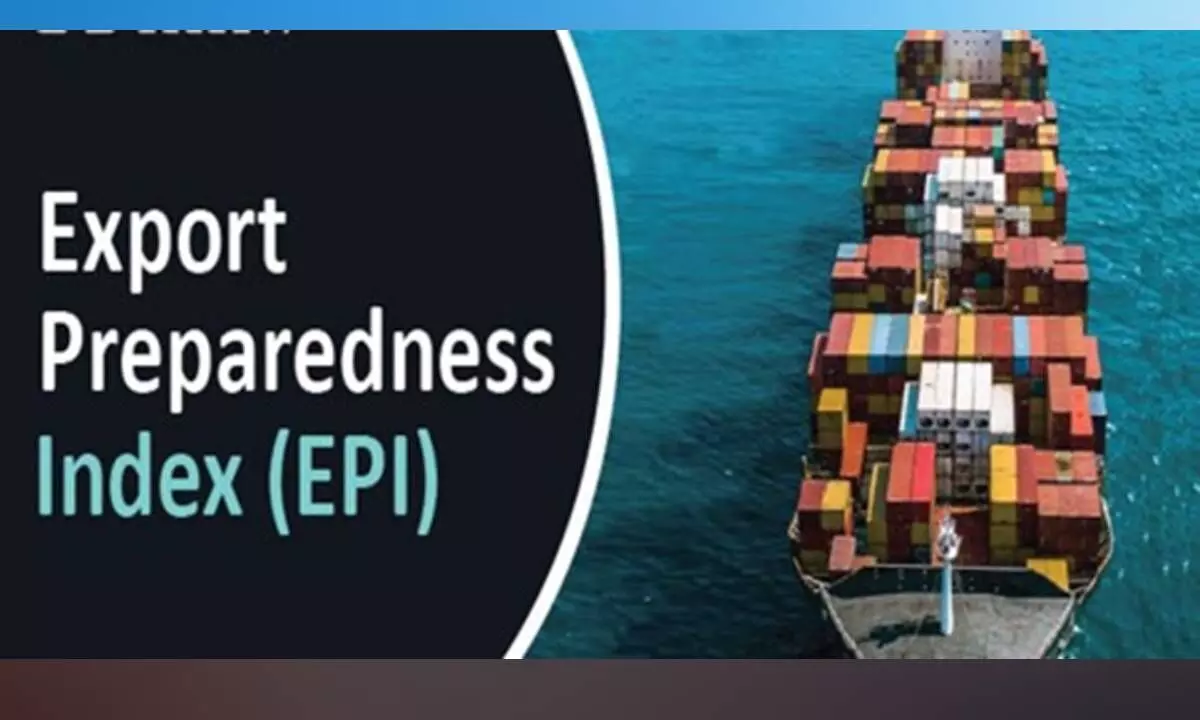Many states have miles to go for building resilient export ecosystem
India’s Foreign Trade Policy-2023 (FTP-2023) aims to reach $2 trillion exports by 2030
image for illustrative purpose

Recently NITI Aayog released the third edition of ‘Export Preparedness Index-2022’ (EPI-2022) for states and Union Territories. The report has been prepared in association with the Institute for Competitiveness, New Delhi, and delves ‘deeper beyond states and examines exports at the district level.’
Academic and industry experts may have divergent views regarding objectivity and efficacy of EPI-2022 but there are some merits in the efforts that have gone into its preparation.
As India is gearing up to become the third largest economy, which brings in economic inclusivity by bridging yawning income gaps among our people and a huge mismatch between per capita income and the ground realities, there is a need for every state and UT to pull up socks and focus on further expansion of their export ecosystem.
As expected, Tamil Nadu has topped EPI-22, followed by Maharashtra, Karnataka, Gujarat, Haryana, Telangana, Uttar Pradesh, Andhra Pradesh, Uttarakhand, Punjab, and Odisha.
In recent years, Gurugram, Faridabad, Sonipat, Ballabhgarh, and Jhajjar in Haryana are emerging as a hub of MSMEs. Several MNCs have also set up their units in different parts of Haryana in close proximity to Delhi. Similarly, Noida, Greater Noida and Kanpur have a significant concentration of export units. A few cities in Punjab and Uttarakhand have a good presence of entities, which make export quality products. It is likewise with Madhya Pradesh, Rajasthan, West Bengal, Himachal Pradesh and Goa.
Those that need to further develop their export ecosystems are Jammu and Kashmir, Delhi, Kerala, Jharkhand, Assam, Bihar, Manipur, Andaman & Nicobar Islands, Chhattisgarh, Tripura, Sikkim, Nagaland, Ladakh, Chandigarh, Puducherry, Meghalaya, Himalayan, Arunachal Pradesh, Dadra Nagar and Haveli & Daman and Diu, Mizoram and Lakshadweep.
In fact, there is a huge scope for India to become a global export player by promoting states and districts as export hubs. We have not yet been able to unlock regional competitiveness and leverage our innate diversity to enhance our export potential. The EPI-2022 seeks to empower state governments with region-specific insights to assist decision-making, identify strengths, address weaknesses, and foster comprehensive growth across States and UTs. It evaluates their performance across four pillars - policy, business ecosystem, export ecosystem, and export performance. These parameters are further based on ten sub-pillars, namely, export promotion policy; institutional framework; business environment; infrastructure; transport connectivity; export infrastructure; trade support; R&D infrastructure; export diversification; and growth orientation. The report encourages state governments to create solutions to their context-specific challenges to exports. The states can also exploit their innate diversity by promoting products unique to them and helping them reach the global market. Consistent investment in research and development can foster innovation, which in turn can facilitate higher efficiency in exports, and diversification of India’s export basket.
Most States and UTs, which have not been able to develop export hubs, need huge public and private investments. The pace of private investment in several States and UTs is sluggish for multiple reasons. The public investment is also not up to the mark. Serious and consistent efforts in identifying new markets and exporting diversified products according to a state’s competitive advantage need to be accelerated. At the release of the report NITI Aayog Vice Chairman Suman Bery rightly said: “As we look towards 2047 and becoming the third largest economy, we need to focus on fostering competitiveness in service and agriculture exports along with manufacturing. To achieve it, comparative advantages of states should be leveraged.”
Exports play a crucial role in a country’s economy, serving as a driving force for growth and development. When a country exports goods and services to other nations, it not only generates revenue but also creates job opportunities and fosters international trade relations. Export-oriented industries often experience increased competitiveness and innovation, as they adapt to international market demands and standards. Additionally, exporting enables us to diversify our sources of income and reduce dependence on domestic markets, making their economies more resilient to fluctuations. With the rise of globalization and advancements in technology, businesses of all sizes can now access global markets more easily, facilitating the exchange of goods, services, and ideas across borders.
Moreover, export-oriented industries often require a skilled workforce to meet international quality standards and compete in global markets. This can lead to the creation of jobs and opportunities for the local population, particularly in sectors that demand specialized skills and knowledge. As more people gain access to employment, income levels may rise, contributing to economic inclusivity. To support exports, a country has to invest in infrastructure improvements such as ports, transportation networks, and communication systems. These investments can have broader economic benefits by enhancing connectivity and accessibility, potentially bringing economic opportunities to previously marginalized regions or communities.
India’s Foreign Trade Policy-2023 (FTP-2023) aims to reach $2 trillion exports by 2030 by shifting from an incentive to remission and entitlement-based regime. It encourages recognition of new towns through ‘Towns of Export Excellence Scheme’ and exporters through ‘Status Holder Scheme.’
The FTP-2023 intends to facilitate exports by streamlining the popular ‘Advance Authorization’ and ‘EPCG’ schemes, and enabling trade from India, boost manufacturing, further enable the ease of doing business, and also works towards making Indian rupee a global currency, adding further impetus to India’s emergence as the global trading hub. It, however, remains to be seen how much is delivered on the ground.
(The writer is a senior journalist, columnist and author. The views expressed are strictly his personal)

